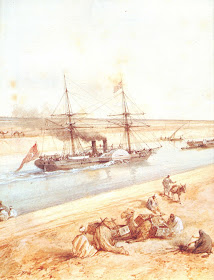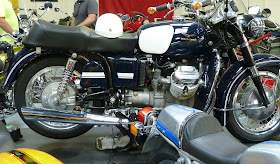Thursday, November 30, 2017
Rough crossings
Much was made of the discomfort experienced by passengers on early ocean liners, here a series of 1890 drawings by W.W. Lloyd illustrates some of the problems.
Villiers-Starmaker/ Metisse, August 1966
The Rickman Brothers made lovely frames, with fibreglass body parts by the Mitchenall Brothers. Apparently, this particular machine was designed by them for Bultaco. The frame was based on the Norton Featherbed, and front suspension could be had as modified Norton Roadholders (as above) or Italian Cerianis.
The name "Metisse", by the way, is French for "mongrel."
Simplex "Senior" motorcycle, 1965
The only American motorcycle manufacturer located in the Deep South, Simplex operated out of New Orleans from 1935 to 1975, when they went bankrupt. The "Senior" model above used a 200cc Villiers engine. Weighing in at 200 pounds, it was advertised as having "flashing performance." ("Also available with horsepower restrictor for junior licensing.") It was offered at $40 U.S. F.O.B. Apparently, the company's profit per motorcycle was only $1.60! It's a wonder they persisted as long as they did.
Scrap!
Wednesday, November 29, 2017
The opening of the Suez canal, 1869
Tuesday, November 28, 2017
Now a word from our sponsor...
After Amelia Earhart crossed the Atlantic in the aircraft "Friendship" with copilots Wilmer "Bill" Stultz and Louis "Slim" Gordon, whe became a media sensation. Here she appears in a cigarette ad, no mention of the guys...
Monday, November 27, 2017
The first Auto vs Airplane race
In 1908 Buick staged a race between their car and this unidentified airplane, thought to have been the first race of its type in what was to become a popular show attraction. Apparently the car was credited with the win. Unfortunately neither the driver or the pilot's names are remembered.
Kitchen of Tomorrow
 |
| Martin Greif, Depression Modern, The Thirties Style in America, Universe Books, 1975 |
"The Kitchen of Tomorrow" as envisioned by the Briggs Manufacturing Company in 1935. The cylindrical device in the center is an electric range.
The company built car bodies for Ford, Chrysler and other car manufacturers. In 1933 they used their deep draw steel stamping technology to produce the first steel metal bathtub. The company was bought by Chrysler in 1953, the plumbing division was sold separately.
WWII cartoons by "Pont"
And my favourite:
From Pont (London: Collins, 1942).
"Pont" (after Pontifex Maximus) was the nom de plume of Graham Laidler, chosen because, when initially preparing for a career as an architect, he did not want his actual name tainted by his side work as a cartoonist. He went on to become one of Punch's most celebrated cartoonists. Born in 1908, he died tragically young in 1940 of polio.
Sunday, November 26, 2017
Miles Aircraft, WW2
The Miles aircraft company largely built trainers. their designs were often technologically and aerodynamic advanced. The company went bankrupt soon after the war, though Fredrick Miles quickly formed a new company, F W Miles which continued to build aircraft. The company was merged with Auster into Beagle Aircraft.
Saturday, November 25, 2017
Featherbed plus Kawasaki equals Trisaki
Many old bike fans are familiar with the idea of a Triton- a Triumph motor in a Norton Featherbed frame- built as specials since the sixties. Many years ago I read an article, possibly in an 80s Classic Bike about someone who had actually installed a Kawasaki Triple in a Manx frame, heresy!
Then I find this picture of Reg Pridmore with his version built apparently about 5 minutes after the Kawasaki H1 was introduced! I'd like to see it without the fairing, apparently the bike is still around, but being restored with the original motor. Kneeslider (scroll down to comments).
Then I find this picture of Reg Pridmore with his version built apparently about 5 minutes after the Kawasaki H1 was introduced! I'd like to see it without the fairing, apparently the bike is still around, but being restored with the original motor. Kneeslider (scroll down to comments).
They used to make things here, Watertown, NY.
They also built a car which they produced in small numbers from 1909 till 1913. The company was quite large, employing 4-500 people at the high point in the early 1920s. In 1925, the business began to dry up and closed in 1926. More here.
Friday, November 24, 2017
Moto Guzzi Ambassador
The first Flying Clipper
An ungainly and awkward looking aircraft, the Sikorsky S-40 was the first of the Pan Am Clipper aircraft used on the route from New York down the east coast of South America. The plane was powered by 4 radial engines and carried 38 passengers in luxury at a stately 110 mph. Three were built and from 1931 till the Second World War they served without incident on that route. More here in the Duke's previous post and from Popular Science 1931
The aircraft played a bit part in the 1933 movie Flying down to Rio.
From Jitterbuzz, "The next to the last scene takes place aboard a luxury PanAm Clipper. Julio drags Belinha away from her omnipresent chaperone and races headlong to catch the next Clipper departing for the USA since (he says) they can be married immediately by the Captain (Pilot). When they board the Clipper (through the unusual marine hatch shown in the photo), the reluctant Belinha is stunned to find Roger in the plane. Julio breaks the engagement so that the lovers can be married. He then jumps out of the plane and parachutes back to the Hotel."
Thursday, November 23, 2017
Convair XFY-1 Pogo
Interesting idea, this was a 1954 experiment in vertical takeoff and landing. Apparently the takeoff part was OK, but it was very difficult to land, as the pilot had to look over his shoulder to see where he was going while being very precise working the controls.
Three were built, only one flew, mostly in tethered practise liftoffs and landings. It was determined that only very experienced pilots were capable of flying it and although it was capable of speeds approaching 500 mph, jets were the future.
Wednesday, November 22, 2017
There's something in the air...
 |
| The American Heritage History of Flight, Simon and Shuster 1962 |
Catapulted from a houseboat in the Potomac river, the first takeoff by pilot Charles Manly on October 7 1903 was unsuccessful, the picture above shows the plane breaking up and falling during the second launch on December 8, 1903.
Nine days later, the Wright brothers achieved the first successful powered heavier than air flight.
Crawford Automobiles
Another manufacturer that came and went so fast they didn't even say goodbye. Soon after this ad appeared in 1909, the company was gone.
Tuesday, November 21, 2017
Shell Oil ads
Diecast airplane
Another nice little diecast toy with a 5 inch wingspan. Maker unknown, no identification, no markings except some stamped numbers "3" on the bottom of one wing, "2197" on the other.
Monday, November 20, 2017
Our Young Aeroplane Scouts in England, 1916
Grand Pianos of the Great Depression
Sunday, November 19, 2017
FCD Railbus
 |
| Geoffrey H Doughty, The New Haven Railroad's Streamline Passenger Fleet 1934-1953, TLC Publishing, 2000 |















































